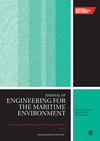基于多模态特征学习的水下目标识别并行卷积神经网络-变换器模型
IF 1.5
4区 工程技术
Q3 ENGINEERING, MARINE
Proceedings of the Institution of Mechanical Engineers, Part M: Journal of Engineering for the Maritime Environment
Pub Date : 2023-12-23
DOI:10.1177/14750902231215410
引用次数: 0
摘要
水下声学目标识别是一个应用广泛的热门研究课题。多变的海洋环境和不断发展的水下移动目标降噪技术使识别任务变得非常复杂。由于输入特征的单一性和网络骨干的局限性,传统的识别方法很难获得实用的表征特征和稳健的识别结果。因此,我们提出了一种基于多模态特征学习的并行卷积神经网络(CNN)-变换器模型,用于水下目标识别。CNN 模块从 Mel-Frequency Cepstral Coefficients (MFCC) 中提取深度特征。变换器捕捉原始时域信号中的全局信息。自适应特征融合模块将两种单模态特征结合起来,构建用于目标识别的联合特征。在 Ships-Ear 数据集中验证了所提方法的有效性,分类的平均准确率达到 98.58%。实验结果表明,我们的模型比传统方法效果更好。本文章由计算机程序翻译,如有差异,请以英文原文为准。
A parallel convolutional neural network-transformer model for underwater target recognition based on multimodal feature learning
Underwater acoustic target recognition is a hot research issue with a wide range of applications. The variable ocean environment and evolving underwater moving target noise reduction techniques greatly complicate the recognition task. Traditional recognition methods are difficult to obtain practical characterization features and robust recognition results due to the singular input features and the limitation of the network backbone. Therefore, We propose a parallel convolutional neural network (CNN)-Transformer model based on multimodal feature learning for underwater target recognition. The CNN module extracts deep features from the Mel-Frequency Cepstral Coefficients (MFCCs). The Transformer captures global information in the original time-domain signal. The two single-modal features are combined by an adaptive feature fusion module to construct joint features for target recognition. The effectiveness of the proposed method was verified in the Ships-Ear dataset, and the average accuracy of classification reached 98.58%. The experimental results show that our model works better than classical methods.
求助全文
通过发布文献求助,成功后即可免费获取论文全文。
去求助
来源期刊

CiteScore
3.90
自引率
11.10%
发文量
77
审稿时长
>12 weeks
期刊介绍:
The Journal of Engineering for the Maritime Environment is concerned with the design, production and operation of engineering artefacts for the maritime environment. The journal straddles the traditional boundaries of naval architecture, marine engineering, offshore/ocean engineering, coastal engineering and port engineering.
 求助内容:
求助内容: 应助结果提醒方式:
应助结果提醒方式:


